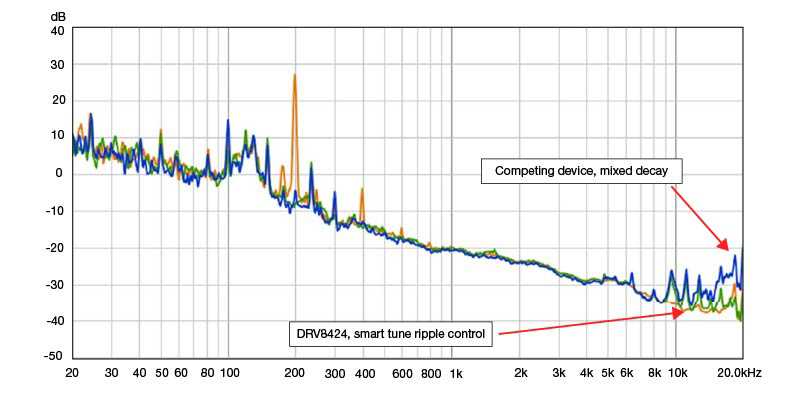Stepper motors are an integral part of systems that need precise positioning, excellent speed control and repeatability of movement. You’ll find stepper motors in 3D printers, textile machines, medical tools, robotics, printers, stage lighting and ATMs.
A stepper motor has two electrical current windings controlled with an H-bridge, and moves in discrete steps defined by a step angle. If you’re designing with this kind of motor, you’ll encounter some common challenges, some of which are driver-related, while others are system-related. In this article, I’ll answer some of the most frequently asked questions I receive about how to mitigate these issues, some of which are mapped out in Figure 1.

Figure 1: Common challenges when designing with stepper motors
Q: What is tuning? What causes it, and why is it important?
A: Stepper motor systems must drive and decay current continuously in order to regulate the current and hold the position of the motor at each step. This creates current ripple. Designers use a combination of fast, slow and mixed-decay modes to control the current through the motor windings. The process of selecting the optimal decay mode is called “tuning.”
Tuning is important, as improper tuning can cause vibration and unwarranted audible noise, also shown in Figure 1. Good tuning directly enables smooth motion, reduces audible noise and improves positional accuracy.
TI’s patented smart tune technology is a decay scheme that adapts itself to changing operating conditions and motor parameters, leading to smoother motion for the stepper motor. Cycle by cycle, smart tune automatically optimizes the decay mode to maintain current regulation, keeping the motor running smoothly, quietly and up to 11°C cooler than using a fixed-decay mode, as detailed in the application note, "Smart Tuning for Efficient Stepper Driving." Smart tune also minimizes motor noise and vibration by preventing current regulation loss. More information can be found in the white paper, "Stepper motors made easy with smart tune." Figures 2a, 2b and 2c show instances of untuned waveforms, while Figure 2d shows a perfectly tuned waveform using smart tune.

Figure 2: Different drive and decay states: untuned, with too much fast decay (a); untuned, with a minimum drive time that’s too long (b); untuned, with a large back-electromotive force (EMF) during slow decay (c); tuned waveform approximating a sine wave using the smart tune decay scheme (d)
Q: What causes high audible noise? Is it possible to reduce audible noise in a system?
A: The amount of audible noise from a stepper motor depends on the type of motor and the operating condition. The sources of noise coming out of a stepper motor can be magnetic, mechanical or electrical. The amount of ripple directly affects the amount of electrical noise in the system. One way to ensure minimum ripple control (and thus noise) is to use the smart tune ripple control available in stepper motor drivers like the DRV8426 and DRV8424, where the off-time (TOFF) adjusts based on operation to achieve the target ripple, as shown in Figure 3. More details can be found in the app note, "How to Reduce Audible Noise in Stepper Motors."

Figure 3: Smart tune ripple control
Figure 4 shows the comparison of audible noise performance using smart tune ripple control with a competing device employing mixed decay. The figure clearly shows the DRV8424 performing as much as 10% better.

Figure 4: Audible noise performance using smart tune ripple control vs. a competing device
Q: What causes motors to vibrate? Are there ways to reduce this vibration and increase motion smoothness?
A: Creating a current ripple requires keeping the current regulated and holding the motor position at each step by continuously driving and decaying the winding current. In a traditional system, using a high ratio of slow decay and increasing the motor speed introduces a significant back-EMF voltage, causing current regulation losses, motor vibration and overheating. Because stepper drivers use open-loop control, there is no reference for position. Additionally, poor channel-to-channel current matching, bad current-sense accuracy and low microstepping levels may result in choppy motion.
Smart tune technology in our DRV8426, DRV8428, and DRV8424 stepper motor drivers detects the change in current and automatically inserts a higher ratio of fast decay to keep the motor in regulation. Additionally, these devices provide 1/256 microstepping and integrated current sensing with tight ±5% current-sense accuracy, smoothing the motion of the motor to its intended location as explained in the app note, "How to Improve Motion Smoothness and Accuracy of Stepper Motors."
Q: Are there ways to reduce the bill-of-materials (BOM) cost and system size?
A: Stepper motor drivers typically require two current-shunt sense resistors to monitor and regulate current. These shunt resistors are expensive, increase BOM costs and require additional routing. Our DRV8426, DRV8424, DRV8434 stepper motor drivers integrate current sensing and eliminate the need to use external, bulky, expensive shunt resistors while achieving ±5% current accuracy. More information can be found in the application note, "Advantages of Integrated Current Sensing." Figure 5 compares the DRV8424/DRV8426 evaluation module (EVM) drawn to scale with competing devices, where the DRV8424/DRV8426 EVM is 75% and 50% smaller than competing device 1 and 2 respectively.

Figure 5: EVM size comparison
If you have a question about designing with stepper motor drivers that I didn’t answer, I hope you’ll ask it below or in the TI E2E Motor drivers forum. My colleagues and I can help throughout every step of your design process.








